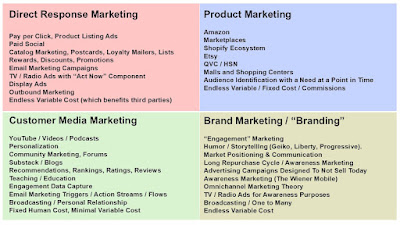You probably keep up to date on the plight of the newspaper industry. In fact, you probably read this little ditty from Clay Shirky a few weeks ago.
I pay close attention to the newspaper industry (and the music industry), because both are so similar to the catalog industry, in so many ways.
Take the music industry. In 1995, I'd drive to Tower Records. In 2002, I burned all of my CDs into MP3s. In 2008, I bought an iPod. In 2010, I bought an iPad. In 2012, I use my iPad, daily, paying Sirius/XM money to stream music, or to listen to ad-supported Yahoo! music, or to occasionally use Spotify (which will likely replace Sirius/XM soon). I consume more music than ever before. But I spend less on music than ever before.
Take the newspaper industry. Via Google Reader, I read more content from the NY Times and the Milwaukee Journal/Sentinel than ever before. I pay for neither, I never get to the threshold either publication has where I have to start paying for content.
Oh, people do get paid. My DSL provider gets paid. Verizon gets paid. DirecTV gets paid.
Think of the catalog as a form of media instead of a tool to encourage the customer to purchase merchandise.
In 1995, I had to get the Damark catalog or the J&R Music World catalog or the Crutchfield catalog, if I wanted to buy electronics. The catalog was the way you were informed, in that way, the catalog was like a newspaper, or a radio station. Better yet, the catalog was free! This meant that the catalog had to be "ad supported", if you will, just like a newspaper or a radio station. There were at least four ways that the catalog was ad supported.
- Pages were literally ad supported ... vendors paid $25,000 for the ability to sell product on a page.
- Gross Margins ... often 60% or better, which were perfectly acceptable to the customer, because the customer couldn't easily find comparable products.
- Shipping and Handling ... I recall a year at Eddie Bauer in the 1990s when all profit in the direct channel came from shipping and handing revenue ... let me repeat, all profit in the direct channel came from shipping and handling revenue.
- List Rental Income ... It was not uncommon for the average cataloger to generate 10% pre-tax profit, with 10% to 25% of the total coming directly from list rental income.
What changed over the next seventeen years?
- Pages can still be ad supported, though advertisers don't necessarily appreciate the demographic audience that receives the catalog.
- Gross Margins can only be high when products are proprietary, unique, in demand, with inventory well-managed.
- Shipping and Handling are being eliminated as a profit center. We can't count on it in the future, folks.
- List Rental Income is dead. The co-ops and Google now earn the money you used to earn.
And access to information sure exploded, didn't it? Now Verizon and Comcast control the pipes that deliver information to us, performing the role the USPS used to play. They partner with Google to show us thirty companies that sell a similar item at a similar price with similar shipping options, destroying gross margins in the process. We end up in overstocked positions, requiring discounts and promotions and flash sales to move product, further eroding margins.
In other words, technology acted in entirely predictable ways, though we didn't see it coming, we simply tried to bolt e-commerce on to catalogs, calling it "multichannel", pretending that the world didn't change, finding case studies to support our belief in the way we wanted business to be.
The world changed.
Now we get to adapt to the world as it exists.
I created the "Traditional", "Transitional", and "Transformational" framework to help us adapt to the world as it exists. Think about newspapers, for instance.
- A Traditional customer gets the news via print, and happily pays to maintain the distribution channel that served him for the past thirty or forty years.
- A Transitional customer browses media online, "mashing up" a personalized news reader (Google Reader or Twitter) or leveraging the Huffington Post or Drudge Report, as examples.
- A Transformational customer might use Flipboard to consume information and links published by trusted friends, and won't ever pay the NY Times for digital content, in fact, this user finds the NY Times to be largely irrelevant.
The Transitional / Transformational customer aren't going back to a print-based newspaper.
We face a similar challenge. We can be catalogers, but we then limit ourselves to a Traditional audience, and we limit ourselves to, at best, half of the Transitional audience. And if we decide to serve the Traditional audience, well, that gets us through 2012 and 2013, but what do we do when this 62 year old customer becomes a 69 year old customer?
Let's start using the Traditional / Transitional / Transformational framework to think about our strategic options, both short-term and long-term. Use the newspaper industry as an unbiased predictor of where our future may head.


No comments:
Post a Comment
Note: Only a member of this blog may post a comment.